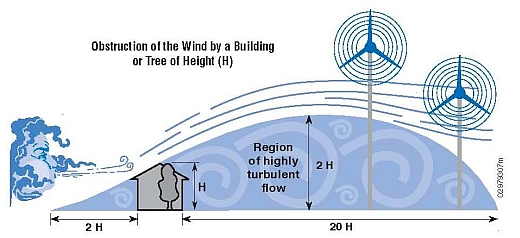Ideal ALP Sites
The ideal site for an anemometer loan has several components. First, there is the intent of the potential lessee. The ideal candidate would have the following characteristics:
- Interested in small scale wind at their site to determine the wind energy potential associated with installing a wind turbine to offset their energy use.
- Interest in renewable energy and promoting wind energy specifically.
- Interest in installing a wind turbine at their site if the measured wind data show reasonable potential and the finances of the project are reasonable to the candidate.
The ideal site for an anemometer tower is one that is flat, free of obstructions for about 300 feet around the site, has access for vehicles, and is at a location where you'd like to install a wind turbine. You can have varied wind resources
within the same property. The anemometer tower is left in place and canot be moved for a year after it is installed, so the location should also be where the best wind is located at the site. You also need to
know about the prevailing directions
of the wind at your site. If you live in
complex terrain, take care in selecting
the installation site. If you site your
wind turbine on the top of or on the
windy side of a hill, for example, you
will have more access to prevailing
winds than in a gully or on the leeward
(sheltered) side of a hill on the
same property. In addition to geologic
formations, you need to consider
existing obstacles such as trees,
houses, and sheds, and you need to
plan for future obstructions such as
new buildings or trees that have not
reached their full height.

Your turbine
needs to be sited upwind of buildings and trees, and it needs to be 30 feet above anything within 300 feet. The farther you
place your wind
turbine from
obstacles such
as buildings or
trees, the less
turbulence you
will encounter and the longer your wind turbine will last. You
also need enough room to raise and
lower the tower for maintenance, and if your tower is guyed, you must allow room for the guy wires.
Whether the system is stand-alone
or grid-connected, you will also need
to take the length of the wire run
between the turbine and the load
(house, batteries, water pumps, etc.)
into consideration. A substantial
amount of electricity can be lost as a
result of the wire resistance - the
longer the wire run, the more electricity
is lost. Using more or larger wire
will also increase your installation
cost. Your wire run losses are greater
when you have direct current (DC)
instead of alternating current (AC).
So, if you have a long wire run, it is
advisable to invert DC to AC.
For further guidance, you should review the Small Wind Electric Systems: A Colorado Consumer's Guide available from the DOE Wind Powering America site or download a copy of the guide here.
|

